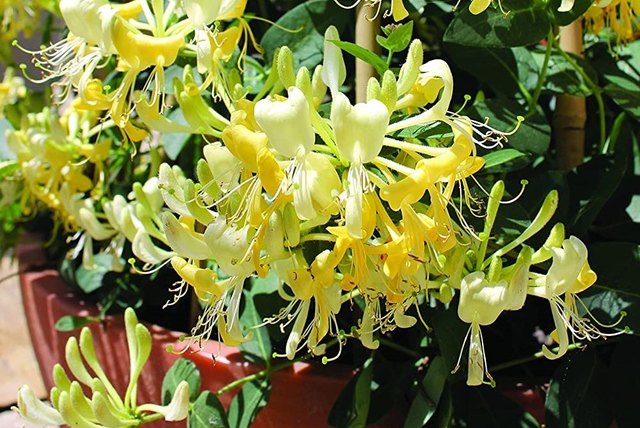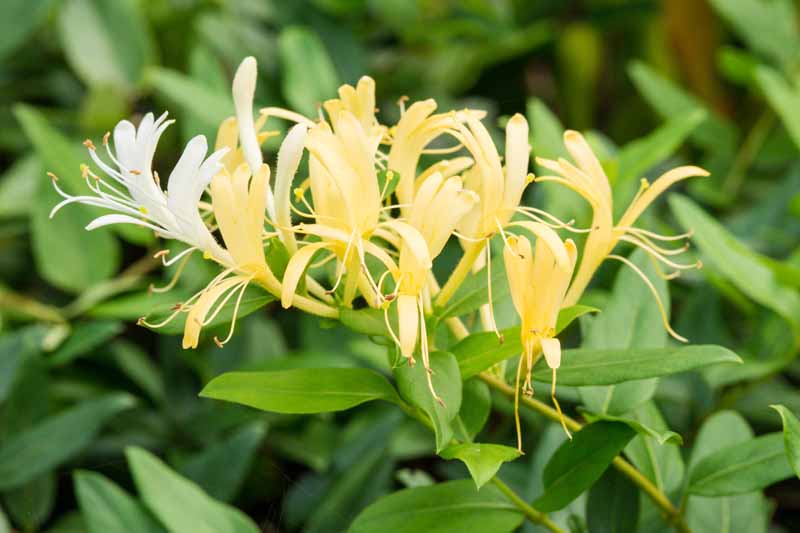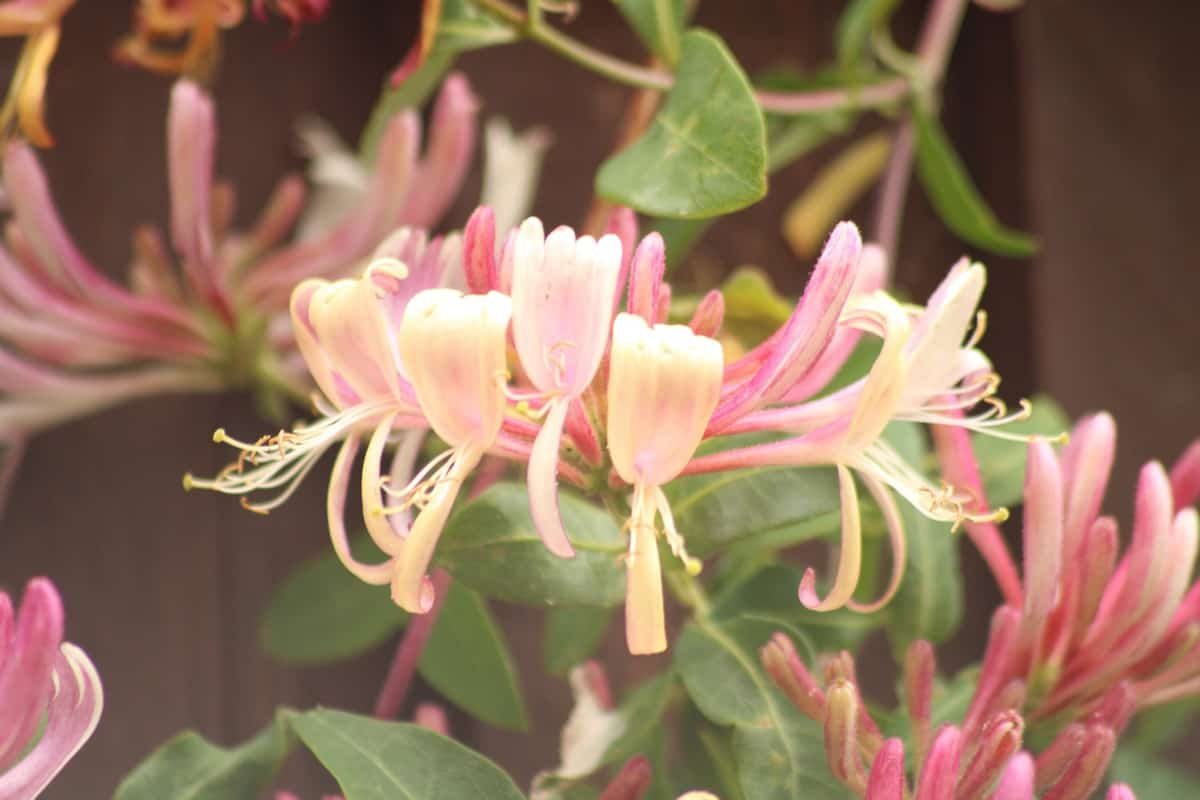Choosing the Right Honeysuckle Variety for Your Garden
With over 180 species of honeysuckle, selecting the right variety for your garden can be a daunting task. However, by understanding the different types of honeysuckle plants, you can make an informed decision that suits your specific climate and garden type. Non-invasive species, such as Lonicera sempervirens and Lonicera ciliosa, are ideal for gardens in the United States, as they do not pose a threat to local ecosystems. Invasive species, like Lonicera japonica and Lonicera maackii, should be avoided, as they can outcompete native plants and cause harm to the environment.
When choosing a honeysuckle variety, consider factors such as bloom color, fragrance, and growth habit. Some popular varieties, like ‘Dropmore Scarlet’ and ‘Major’, offer vibrant red flowers and a sweet fragrance, while others, like ‘Goldflame’ and ‘Coral Honeysuckle’, provide a more subtle, yellow-orange bloom. By selecting a variety that suits your garden’s specific conditions, you can ensure a healthy and thriving honeysuckle plant.
In addition to considering the type of honeysuckle, it’s also essential to think about the mature size of the plant and its growth habits. Some honeysuckle varieties can grow quite large, up to 20 feet tall, while others remain more compact, around 6-8 feet tall. By choosing a variety that fits your garden’s space constraints, you can avoid pruning and training issues down the line.
Ultimately, the key to successfully growing honeysuckle is to choose a variety that is well-suited to your garden’s specific conditions. By doing your research and selecting a non-invasive, disease-resistant variety, you can enjoy the beauty and fragrance of honeysuckle in your garden for years to come. Whether you’re looking to attract hummingbirds, create a fragrant hedge, or simply add some color to your garden, there’s a honeysuckle variety out there for you.
Preparing the Perfect Environment for Honeysuckle Growth
Providing honeysuckle plants with the right amount of sunlight, water, and soil nutrients is crucial for their growth and development. When it comes to sunlight, honeysuckle plants prefer partial shade to full sun, depending on the variety. In general, it’s best to provide honeysuckle plants with at least 4-6 hours of direct sunlight per day. However, in warmer climates, it’s essential to provide some shade to prevent scorching of the leaves.
Watering is also critical for honeysuckle plants. They prefer well-draining soil and should be watered regularly, especially during the first year after planting. However, it’s essential to avoid overwatering, as this can lead to root rot and other problems. A good rule of thumb is to water honeysuckle plants when the top 2-3 inches of soil feel dry to the touch.
Soil preparation is also vital for honeysuckle growth. Honeysuckle plants prefer slightly acidic to neutral soil pH, ranging from 6.0 to 7.0. To prepare the soil, mix in a 2-inch layer of compost or well-rotted manure. This will help to improve soil fertility and drainage. Additionally, consider adding a balanced fertilizer in the early growing season to promote healthy growth.
When choosing a location for your honeysuckle plant, consider the mature size of the plant and its growth habits. Honeysuckle plants can grow quite large, so make sure to provide enough space for the plant to spread out. Also, consider the location of nearby plants and structures, as honeysuckle plants can be quite vigorous and may require regular pruning to keep them under control.
By providing honeysuckle plants with the right amount of sunlight, water, and soil nutrients, you can create an ideal environment for growth and development. With proper care and attention, honeysuckle plants can thrive and provide beautiful blooms and fragrance for years to come. Whether you’re looking to learn how to plant and grow honeysuckle or simply want to improve your existing honeysuckle plant, following these tips can help you achieve success.
How to Plant Honeysuckle: A Step-by-Step Guide
Planting honeysuckle is a relatively straightforward process, but it does require some care and attention to detail. To ensure successful growth and development, follow these steps to plant your honeysuckle:
Step 1: Prepare the Planting Site – Before planting, make sure the area is clear of any debris or weeds. If your soil is heavy clay or sandy, mix in some organic matter like compost or well-rotted manure to improve its structure.
Step 2: Dig the Planting Hole – Dig a hole that is twice as wide and just as deep as the root ball of the honeysuckle plant. If you’re planting a bare-root honeysuckle, make the hole slightly deeper to accommodate the roots.
Step 3: Plant the Honeysuckle – Gently remove the honeysuckle plant from its container or burlap, taking care not to disturb the roots. Place the plant in the hole, making sure the crown (where the stem meets the roots) is level with the soil surface.
Step 4: Fill in the Hole – Fill in the hole with a mixture of soil and organic matter, tamping it down gently as you go to prevent air pockets. Make sure the soil is firmly packed around the roots to prevent settling.
Step 5: Water and Mulch – Water the honeysuckle plant thoroughly after planting, and apply a layer of mulch to retain moisture and suppress weeds. Keep the mulch a few inches away from the base of the plant to prevent rot.
Planting Depth and Spacing – Plant honeysuckle plants at the same depth as they were in the container or burlap, and space them 3-6 feet apart, depending on the variety. For climbing honeysuckle, provide a trellis or other support for the plant to grow up.
Soil Preparation – Honeysuckle plants prefer well-draining soil that is rich in organic matter. If your soil is poor or lacking in nutrients, consider adding a balanced fertilizer according to the manufacturer’s instructions.
By following these steps and tips, you can successfully plant and grow honeysuckle in your garden. With proper care and attention, honeysuckle plants can thrive and provide beautiful blooms and fragrance for years to come.
Supporting Honeysuckle Growth: Tips for Training and Pruning
As honeysuckle plants grow, they require support to maintain their shape and promote healthy growth. Providing the right support can also help prevent overgrowth and keep the plant looking its best. Here are some tips for training and pruning honeysuckle plants:
Training Honeysuckle – Honeysuckle plants can be trained to grow up a trellis, arbor, or other support. To train your honeysuckle, start by gently twining the stems around the support. Use soft ties or clips to secure the stems in place, taking care not to damage the plant.
Pruning Honeysuckle – Pruning is an essential part of maintaining honeysuckle plants. Prune your honeysuckle in the late winter or early spring, removing any dead or damaged stems. Cut back the stems to about 12 inches from the ground, making clean cuts just above a bud or lateral branch.
Pruning for Shape – To maintain the shape of your honeysuckle plant, prune it regularly throughout the growing season. Remove any stems that are growing outside of the desired shape, and trim back the tips of the stems to encourage branching.
Pruning for Size – If you need to control the size of your honeysuckle plant, prune it more heavily. Cut back the stems to about 6 inches from the ground, making clean cuts just above a bud or lateral branch. This will help control the size of the plant and promote new growth.
Pruning for Blooms – To promote blooming, prune your honeysuckle plant in the late winter or early spring. Remove any dead or damaged stems, and cut back the stems to about 12 inches from the ground. This will help promote new growth and encourage blooming.
By providing the right support and pruning your honeysuckle plant regularly, you can promote healthy growth and encourage blooming. With proper care and attention, honeysuckle plants can thrive and provide beautiful blooms and fragrance for years to come.
Common Pests and Diseases: How to Keep Your Honeysuckle Healthy
Honeysuckle plants are generally hardy and resistant to many pests and diseases. However, like all plants, they can be susceptible to certain issues if not properly cared for. Regular monitoring and maintenance can help prevent and treat common problems, ensuring the continued health and beauty of your honeysuckle.
Aphids, whiteflies, and spider mites are common pests that can infest honeysuckle plants. These tiny insects feed on the plant’s sap, causing curled or distorted leaves. To control infestations, spray the plant with a strong jet of water to dislodge the pests, or use insecticidal soap or neem oil according to the product’s instructions.
Honeysuckle plants can also be affected by fungal diseases such as powdery mildew and leaf spot. These diseases are often caused by excessive moisture and poor air circulation. To prevent fungal diseases, ensure good air circulation around the plant, and avoid overhead watering. Instead, water at the base of the plant to minimize moisture on the leaves.
Root rot is another common issue that can affect honeysuckle plants, particularly if the soil is waterlogged or poorly drained. To prevent root rot, ensure the soil drains well, and avoid overwatering. If you suspect root rot, inspect the roots and remove any affected areas to prevent the spread of the disease.
Regular pruning and training can also help prevent pests and diseases by promoting healthy growth and air circulation. Remove any dead or damaged leaves or stems, and thin out the plant to allow for good air circulation.
By being aware of these common pests and diseases, you can take steps to prevent and treat them, ensuring your honeysuckle plant remains healthy and thrives. Regular maintenance and monitoring are key to growing a beautiful and fragrant honeysuckle plant.
Fertilizing and Mulching: How to Keep Your Honeysuckle Thriving
Fertilizing and mulching are essential steps in maintaining the health and vigor of honeysuckle plants. By providing the right nutrients and protecting the soil, you can promote healthy growth, encourage blooming, and prevent common problems.
When it comes to fertilizing honeysuckle, a balanced fertilizer with a ratio of 10-10-10 (nitrogen-phosphorus-potassium) is a good starting point. Apply the fertilizer in the early growing season, following the manufacturer’s instructions for application rates. You can also consider using a fertilizer specifically formulated for flowering plants, as these products often contain additional micronutrients that promote blooming.
In addition to fertilizing, mulching is an effective way to retain moisture, suppress weeds, and regulate soil temperature. Organic mulches like wood chips, bark, or straw are good options for honeysuckle plants. Apply a 2-3 inch layer of mulch around the base of the plant, keeping it a few inches away from the stem to prevent rot.
Another option is to use a layer of compost or well-rotted manure as a mulch. These materials are rich in nutrients and can help improve soil fertility over time. Simply spread a 2-3 inch layer of compost or manure around the base of the plant, and replenish as needed.
When to fertilize and mulch honeysuckle plants depends on the specific growing conditions and climate. In general, it’s best to fertilize in the early growing season, and mulch in the spring or fall when the weather is cooler. Avoid fertilizing or mulching during the hottest part of the summer, as this can cause stress to the plant.
By incorporating fertilizing and mulching into your honeysuckle care routine, you can promote healthy growth, encourage blooming, and enjoy the sweet scent of these beautiful plants. Remember to follow the specific instructions for the products you use, and take care to avoid over-fertilizing or mulching, which can cause more harm than good.
With proper fertilizing and mulching, you can enjoy the many benefits of honeysuckle plants, from their fragrant blooms to their ability to attract pollinators and other wildlife. By following these simple tips, you can keep your honeysuckle plants thriving and enjoy their beauty for years to come.
Propagating Honeysuckle: How to Share Your Favorite Variety
Propagating honeysuckle plants is a great way to share your favorite variety with friends and family, or to create new plants for your own garden. There are several methods for propagating honeysuckle, including taking cuttings, layering, and dividing established plants.
Taking cuttings is a popular method for propagating honeysuckle. To take a cutting, choose a healthy stem with at least two nodes (the joint where a leaf meets the stem). Cut the stem from the plant just above a node, and remove any lower leaves that would be submerged in water. Place the cutting in a glass of water or a propagation tray filled with water, and keep it in a warm, bright location. Roots should develop within 1-2 weeks, at which point the cutting can be planted in soil.
Layering is another method for propagating honeysuckle. To layer a honeysuckle plant, bend a long stem down to the ground and secure it with a rock or a U-shaped wire. Cover the buried portion of the stem with soil, and keep it moist. Roots should develop within 1-2 months, at which point the layered stem can be cut from the parent plant and planted in a new location.
Dividing established plants is a simple way to propagate honeysuckle. To divide a honeysuckle plant, dig it up in the early spring or fall, and gently separate the roots. Replant the separated sections in a new location, and keep them well-watered until they become established.
Regardless of the method used, it’s essential to provide the new plants with the right conditions to thrive. This includes plenty of sunlight, water, and nutrients. With proper care, the new plants should grow and flourish, providing you with a bountiful supply of fragrant flowers and attractive foliage.
Propagating honeysuckle plants is a fun and rewarding experience, and it’s a great way to share your passion for gardening with others. By following these simple steps, you can create new plants and enjoy the beauty and fragrance of honeysuckle for years to come.
When propagating honeysuckle, it’s essential to remember that some varieties can be invasive. Be sure to check with local authorities before sharing or planting honeysuckle in your area, and take steps to prevent its spread if necessary.
By propagating honeysuckle plants, you can enjoy the many benefits of these beautiful flowers, from their fragrance and attractiveness to their ability to attract pollinators and other wildlife. With the right care and attention, your new plants should thrive and provide you with a lifetime of enjoyment.
Enjoying the Fruits of Your Labor: How to Use Honeysuckle in Your Garden
Honeysuckle plants are incredibly versatile and can be used in a variety of ways to add beauty and fragrance to your garden. Whether you’re looking to create a stunning display of flowers, a lush groundcover, or a fragrant hedge, honeysuckle is an excellent choice.
One of the most popular ways to use honeysuckle is as a trellis plant. With its twining stems and fragrant flowers, honeysuckle is perfect for training up a trellis or arbor. Simply plant the honeysuckle at the base of the trellis and train the stems to climb up the support. As the plant grows, it will produce a stunning display of flowers that will attract pollinators and other wildlife.
Honeysuckle can also be used as a groundcover, particularly in areas with poor soil or full sun. The plant’s spreading habit and ability to tolerate drought make it an excellent choice for areas where other plants may struggle to thrive. Simply plant the honeysuckle in the desired area and allow it to spread. As the plant grows, it will produce a lush mat of foliage and fragrant flowers.
In addition to its use as a trellis plant or groundcover, honeysuckle can also be used as a hedge plant. The plant’s dense foliage and fragrant flowers make it an excellent choice for creating a beautiful and fragrant hedge. Simply plant the honeysuckle in the desired location and prune it regularly to maintain the desired shape.
Another way to use honeysuckle is in a container garden. The plant’s compact growth habit and ability to thrive in poor soil make it an excellent choice for containers. Simply plant the honeysuckle in a container with good drainage and provide it with regular watering and fertilization. As the plant grows, it will produce a stunning display of flowers that will attract pollinators and other wildlife.
Regardless of how you choose to use honeysuckle in your garden, it’s essential to provide the plant with the right conditions to thrive. This includes plenty of sunlight, water, and nutrients. With proper care, honeysuckle will produce a stunning display of flowers and foliage that will add beauty and fragrance to your garden.
By incorporating honeysuckle into your garden design, you can create a beautiful and fragrant outdoor space that will attract pollinators and other wildlife. Whether you’re looking to create a stunning display of flowers, a lush groundcover, or a fragrant hedge, honeysuckle is an excellent choice.
With its versatility, beauty, and fragrance, honeysuckle is an excellent addition to any garden. By following the tips and techniques outlined in this article, you can learn how to plant and grow honeysuckle and enjoy its many benefits for years to come.








